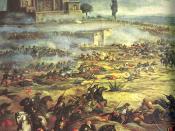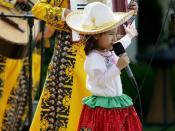It's the fifth of May, or Cinco de Mayo, and although it is not an official holiday in Mexico, it is barely recognized there, that doesn't stop Mexicans living north of the Rio Grande from making it their biggest cultural celebration of the year. There are about 20 million Mexicans and Americans with Mexican heritage now living in the U.S. Throw in the thousands of honorary Mexicans who just happen to like tequila, tortillas and mariachis and you've got a party in some neighborhoods that rivals St. Patrick's Day's.
Even with all its red-white-and-green flag-waving and cries of Viva Mexico, Cinco de Mayo seems not to be as much an expression of hard-core nationalism as a day to celebrate Mexican tradition and the survival of that country's emigrants in this new land. Some union leaders will try to use the day as Cesar Chavez did in California -- to recruit new members -- but for most of the celebrants it will be a weekend of street fairs, family parties and soccer games.
Yet it is worth reminding ourselves, before the tequila goes to our heads, that Cinco de Mayo refers to an extraordinary imperial moment in the history of the New World, when a Great Power in Europe thought to contest Mexico's right to exist as a nation.
But Cinco de Mayo is not Mexican Independence Day. That falls on Sept. 16, commemorating the day in 1810 when a Mexican priest delivered El Grito, or "the cry" of independence. The Mexican rebels eventually won sovereignty from Spain in 1821.
But four decades later, amid financial crisis, Mexico's President Benito Juarez decreed a debt moratorium, to the horror of his main creditors -- England, Spain and France. Supposedly to collect their debts, these European powers landed troops in Veracruz.


